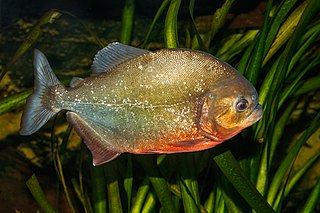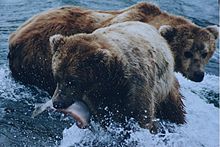
A carnivore, or meat-eater, is an animal or plant whose food and energy requirements derive from the consumption of animal tissues whether through hunting or scavenging.

Food is any substance consumed by an organism for nutritional support. Food is usually of plant, animal, or fungal origin and contains essential nutrients such as carbohydrates, fats, proteins, vitamins, or minerals. The substance is ingested by an organism and assimilated by the organism's cells to provide energy, maintain life, or stimulate growth. Different species of animals have different feeding behaviours that satisfy the needs of their metabolisms and have evolved to fill a specific ecological niche within specific geographical contexts.

Nutrition is the biochemical and physiological process by which an organism uses food to support its life. It provides organisms with nutrients, which can be metabolized to create energy and chemical structures. Failure to obtain the required amount of nutrients causes malnutrition. Nutritional science is the study of nutrition, though it typically emphasizes human nutrition.

The ringtail is a mammal of the raccoon family native to arid regions of North America. It is widely distributed and well adapted to disturbed areas. It has been legally trapped for its fur. It is listed as Least Concern on the IUCN Red List. The species is known by variety of different names, such as ring-tailed cat, miner's cat, civet cat, and cacomistle, though the last of these can refer to B. sumichrasti.

Eating is the ingestion of food. In biology, this is typically done to provide a heterotrophic organism with energy and nutrients and to allow for growth. Animals and other heterotrophs must eat in order to survive — carnivores eat other animals, herbivores eat plants, omnivores consume a mixture of both plant and animal matter, and detritivores eat detritus. Fungi digest organic matter outside their bodies as opposed to animals that digest their food inside their bodies.

An insectivore is a carnivorous animal or plant that eats insects. An alternative term is entomophage, which can also refer to the human practice of eating insects.

In nutrition, diet is the sum of food consumed by a person or other organism. The word diet often implies the use of specific intake of nutrition for health or weight-management reasons. Although humans are omnivores, each culture and each person holds some food preferences or some food taboos. This may be due to personal tastes or ethical reasons. Individual dietary choices may be more or less healthy.

Caniformia is a suborder within the order Carnivora consisting of "dog-like" carnivorans. They include dogs, bears, raccoons, and mustelids. The Pinnipedia are also assigned to this group. The center of diversification for the Caniformia is North America and northern Eurasia. Caniformia stands in contrast to the other suborder of Carnivora, the Feliformia, the center of diversification of which was in Africa and southern Asia.

In zoology, a folivore is a herbivore that specializes in eating leaves. Mature leaves contain a high proportion of hard-to-digest cellulose, less energy than other types of foods, and often toxic compounds. For this reason, folivorous animals tend to have long digestive tracts and slow metabolisms. Many enlist the help of symbiotic bacteria to release the nutrients in their diet. Additionally, as has been observed in folivorous primates, they exhibit a strong preference for immature leaves which tend to be easier to masticate, are higher in energy and protein, and lower in fibre and poisons than more mature fibrous leaves.

The red-bellied piranha, also known as the red piranha, is a type of piranha native to South America, found in the Amazon, Paraguay, Paraná and Essequibo basins, as well as coastal rivers of northeastern Brazil. This fish is locally abundant in its freshwater habitat. They are omnivorous foragers and feed on insects, worms, crustaceans, and fish. They are not a migratory species but do travel to seek out conditions conducive to breeding and spawning during periods of increased rainfall. Red-bellied piranhas often travel in shoals as a predatory defense but rarely exhibit group hunting behavior. Acoustic communication is common and is sometimes exhibited along with aggressive behaviors. They are a popular aquarium fish.

A protocarnivorous plant, according to some definitions, traps and kills insects or other animals but lacks the ability to either directly digest or absorb nutrients from its prey like a carnivorous plant. The morphological adaptations such as sticky trichomes or pitfall traps of protocarnivorous plants parallel the trap structures of confirmed carnivorous plants.
The wildlife of Iraq includes its flora and fauna and their natural habitats. Iraq has multiple biomes from mountainous region in the north to the wet marshlands along the Euphrates river. The western part of the country is mainly desert and some semi-arid regions. As of 2001, seven of Iraq's mammal species and 12 of its bird species were endangered. The endangered species include the northern bald ibis and Persian fallow deer. The Syrian wild ass is extinct, and the Saudi Arabian dorcas gazelle was declared extinct in 2008.

Feliformia is a suborder within the order Carnivora consisting of "cat-like" carnivorans, including cats, hyenas, mongooses, viverrids, and related taxa. Feliformia stands in contrast to the other suborder of Carnivora, Caniformia.

The trophic level of an organism is the position it occupies in a food web. A food chain is a succession of organisms that eat other organisms and may, in turn, be eaten themselves. The trophic level of an organism is the number of steps it is from the start of the chain. A food web starts at trophic level 1 with primary producers such as plants, can move to herbivores at level 2, carnivores at level 3 or higher, and typically finish with apex predators at level 4 or 5. The path along the chain can form either a one-way flow or a food "web". Ecological communities with higher biodiversity form more complex trophic paths.

Carnivorous plants are plants that derive some or most of their nutrients from trapping and consuming animals or protozoans, typically insects and other arthropods, and occasionally small mammals and birds. They still generate all of their energy from photosynthesis. They have adapted to grow in waterlogged sunny places where the soil is thin or poor in nutrients, especially nitrogen, such as acidic bogs. They can be found on all continents except Antarctica, as well as many Pacific islands. In 1875, Charles Darwin published Insectivorous Plants, the first treatise to recognize the significance of carnivory in plants, describing years of painstaking research.

A mesocarnivore is an animal whose diet consists of 50–70% meat with the balance consisting of non-vertebrate foods which may include insects, fungi, fruits, other plant material and any food that is available to them. Mesocarnivores are from a large family group of mammalian carnivores and vary from small to medium sized, which are less than fifteen kilograms. Mesocarnivores are seen today among the Canidae, Viverridae (civets), Mustelidae, Procyonidae, Mephitidae (skunks), and Herpestidae. The red fox is also the most common of the mesocarnivores in Europe and has a high population density in the areas they reside.
A consumer in a food chain is a living creature that eats organisms from a different population. A consumer is a heterotroph and a producer is an autotroph. Like sea angels, they take in organic moles by consuming other organisms, so they are commonly called consumers. Heterotrophs can be classified by what they usually eat as herbivores, carnivores, omnivores, or decomposers. On the other hand, autotrophs are organisms that use energy directly from the sun or from chemical bonds. Autotrophs are vital to all ecosystems because all organisms need organic molecules, and only autotrophs can produce them from inorganic compounds. Autotrophs are classified as either photoautotrophs or chemoautotrophs.
Consumer–resource interactions are the core motif of ecological food chains or food webs, and are an umbrella term for a variety of more specialized types of biological species interactions including prey-predator, host-parasite, plant-herbivore and victim-exploiter systems. These kinds of interactions have been studied and modeled by population ecologists for nearly a century. Species at the bottom of the food chain, such as algae and other autotrophs, consume non-biological resources, such as minerals and nutrients of various kinds, and they derive their energy from light (photons) or chemical sources. Species higher up in the food chain survive by consuming other species and can be classified by what they eat and how they obtain or find their food.
Lepidosaur herbivory describes herbivorous lepidosaurs. Living non-avian reptiles form a paraphyletic group that consists of over 9,000 species of crocodiles, turtles, and lepidosaurs. The most diverse group, Lepidosauria, is first known from the Middle Triassic fossils, but likely originated in the Permian. Living lepidosaurs, which include snakes, lizards, and rhynchocephalians, occupy a wide range of environments and niches. The lepidosaurs have many similar anatomical morphology like transverse cloaca, distal tongue, superficial teeth attachment, fused pelvic bones etc. Though widely viewed as obligate carnivores, a small number of lepidosaurs are known to consume plant material. For example, there are roughly 3,300 species of living lizards and approximately 3% of them eat at least some plants. Though the exact definition of herbivory varies significantly between scientists, most define herbivorous lepidosaurs as those that consume plants for approximately 70-90% of its diet.


















